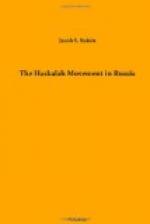But the tide of Haskalah was not to be stemmed. The “blessed heritage of noble passion,” the burning desire for enlightenment and improvement asserted itself at all hazards. The note of despair was lost in the call for action. Odessa continued to be in the forefront. There technical institutes for boys and girls were established in addition to the previously existing public schools. A society by the name of Trud (Labor) was organized (October 11, 1864), for the purpose of teaching useful trades. Its school has ever since been the crown of the institutions of the sort. It was provided with the most modern improvements, a workshop for mechanics and an iron foundry, and it offered a post-graduate course. A similar trade school (remeslenoye uchilishche) had been in existence since May 1, 1862, in Zhitomir, where, besides geometry, mechanics, chemistry, physics, etc., instruction was given in carpentry, turning, tin, copper, and blacksmith work.[9] Through the efforts of Rabbi Solomon Zalkind Minor a Sabbath School and a Night School for artisans were opened in Minsk (1861), and a reference and circulating library for the general public (1863), and similar educational institutions were soon called into existence in many other cities.
Those were the days of organizing and consolidating among Jews and Gentiles alike. At the time when Abraham Lincoln was proclaiming his famous “United we stand, divided we fall,” Julius Slovacki in Poland pleaded the cause of the peasantry of his country, and the Alliance Israelite Universelle issued a call to the entire house of Israel “to defend the honor of the Jewish name wherever it is attacked; to encourage, by all means at our disposal, the pursuit of useful handicrafts; to combat, where necessary, the ignorance and vice engendered by oppression; to work, by the power of persuasion and by all the moral influences at our command, for the emancipation of our brethren who still suffer under the burden of exceptional legislation; to hasten and solidify complete enfranchisement by the intellectual and moral regeneration of our brethren.” A powerful movement for the upliftment of the masses was also taking hold of the educated classes among the Russians. Professor Kostomarov started a systematic campaign for the education of the common people. A species of philanthropic intoxication seized upon the more enlightened Russian youth. A society of Narodniki, or Common People, so-called, was organized. Young men and women renounced high rank, and students came out of their seclusion and joined the people, dressed in their garb, spoke their dialect, led their life, and, having won their confidence, gradually opened their minds to value the blessings of education, and their hearts to desire them. These examples from within and without resulted in a similar attempt among the Russian Jews. An organization was perfected (December, 1863) which exercised a great civilizing influence for almost half a century, the Society for the Promotion of Haskalah among the Jews of Russia.




